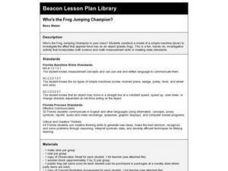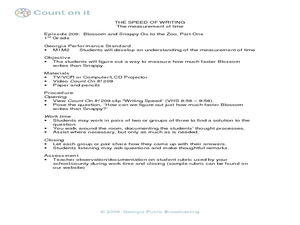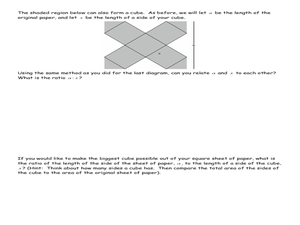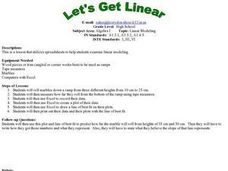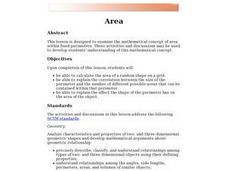Curated OER
Who's the Frog Jumping Champion?
Students use a simple machine (a lever) to launch a plastic frog. students determine who is able to make their frog "jump" the farthest and graph the results.
Curated OER
Making a Family Newsletter: Using a Word Template
Young scholars create a one-page family newsletter about a selected person in their family. They bring in a photo or use a digital camera to take a picture of their selected family member, and use a newsletter template to write and...
Curated OER
The Bell Curve
Learners explore the concept of the bell curve. In this bell curve lesson, students discuss the controversy associated with the bell curve. Learners use an applet to explore a normal distribution. Students discuss mean, median, mode,...
Curated OER
Statistics
High schoolers log their computer usage hours. They determine the mean, median, mode and standard deviation of the collected data. They make a frequency histogram of the grouped data, both on graph paper, and on the TI 83+ graphing...
Curated OER
The Speed of Writing
First graders investigate how to measure time. In this time analysis lesson plan, 1st graders investigate ways to measure the time difference between two people writing. Students share their time measuring ideas with their...
Curated OER
The Toilet Paper Solar System
Young scholars classify the planets in the solar system, study planetary objects, and measure the relative distance between planets. In this solar system lesson, students use toilet paper to complete a scale model of the distance between...
Curated OER
Origami Cube
Learners compare two lengths using the area of a square. In this geometry lesson, students solve problems using ratio and proportion of the two shapes. They solve equations by taking the square root of both sides.
Curated OER
Make Me Metric
Sixth graders explore standard and nonstandard measurement. In this measurement instructional activity, 6th graders estimate the lengths of different objects and write about their observations during measuring. Students work in...
Curated OER
Estimation Challenge
Students calculate the length of the classroom using non-standard units of measurement and estimation. Using a cracker box, they discuss measuring various objects in the room as a class, and independently estimate and measure the length...
Curated OER
Making Metric And Customary Rulers
Students create a ruler for the purpose of measurement using the standard and metric systems. The rulers are of different lengths and are compared to one another. Then students make conversions of different lengths using both systems of...
Curated OER
Finding Areas of Triangles, Rectangles, and Circles
Students find the areas of geometric shapes. In this geometry instructional activity students find and measure the sides, perimeters, and areas of quadrilaterals, triangles, and circles. Students relate the measures to the others by...
Curated OER
Iron in Foods
Students determine the amount of iron in a sample of cereal. In this iron lesson plan, students use a computer colorimeter to measure the amount of light absorbed by the solutions. They create a calibration curve using standard solutions...
Curated OER
Acceleration, Drag, Gravity, Motion, Forces, and Friction
Eighth graders build and run mousetrap cars in order to measure distance, time, and mass for their cars. They use these measurements to calculate average speed and kinetic energy, then create a slide show to visually explain how the car...
Curated OER
What Does Time Have to Do with it?
Students investigate time. In this investigative lesson, students run through an obstacle course using standard timers. They record the time and apply this knowledge to problems in math. Students record their predictions, and graph...
Curated OER
Comparing Data
Eighth graders create a survey, gather data and describe the data using measures of central tendency (mean, median and mode) and spread (range, quartiles, and interquartile range). Students use these measures to interpret, compare and...
Curated OER
Types And Magnitudes Of Earthquakes
Learners investigate the concept of earthquakes and the different types of magnitudes. They research the Richter scale and how it is used to measure the intensities of earthquakes. Students then apply the concept by completing a...
Curated OER
Math/Technology: Measuring Objects
Third graders create Powerpoint templates of pictures they have taken. Using both standard and metrric measurement units, they describe what units of measurement they would use for each object. In the computer lab, they work in pairs to...
Curated OER
Measurements Around the Classroom
Third graders practice measuring items by examining classroom objects. In this geometry lesson plan, 3rd graders utilize measuring tools to find the weight, time, length or temperature of specific classroom items. Students...
Curated OER
Let's Get Linear
Math whizzes utilize spreadsheets to examine linear modeling. They roll marbles down a ramp from three different heights and measure how far they roll. They use Excel to record their data and create a plot of their data.
Curated OER
Spectrophotometer Determination of an Equilibrium Constant
Students determine an equilibrium constant using a spectrophotometer. In this equilibrium lesson plan, students calibrate a spectrophotometer with 5 solutions in order to prepare the spectrophotometer for the experiment. Students measure...
Institute of Electrical and Electronics Engineers
Exploring at the Nanoscale
Nano-nano! Nanotechnology can seem like it's from another planet! After learning about this tiny technology, collaborative groups experiment with how smaller particles affect chemical reactions. They do this by immersing a whole and a...
Teach Engineering
Breathing Cells
Pairs work together to determine whether unknown solutions are either acids or bases by using a red cabbage indicator solution. After determining the general pH of the unknown solution, classmates blow into the same indicator after...
Curated OER
Area Applet
Elementary math classes calculate the area of a shape and explain the correlation between the size of the perimeter and the areas that can be contained within that perimeter. They also explain the effect the shape of the perimeter has on...
Carnegie Mellon University
Battery Workshop
Introduce your class to the workings and parts of a battery-operated circuit. Pairs of pupils use lemons to make batteries and measure voltage and current with a multimeter. An accompanying worksheet is used for recording values and...
